You’re so busy with all your design projects that you haven’t even had a chance to keep up with the industry news and latest web design statistics.
But when the industry is constantly changing and the design of your client’s website can be the difference between a potential customer staying or leaving, it's essential to know what’s important to users who visit your websites.
There are many different statistics about web design out there, but we’ve gathered 49 interesting web design stats to help you stay current and share with your clients.
Mobile-friendly & responsive web design statistics
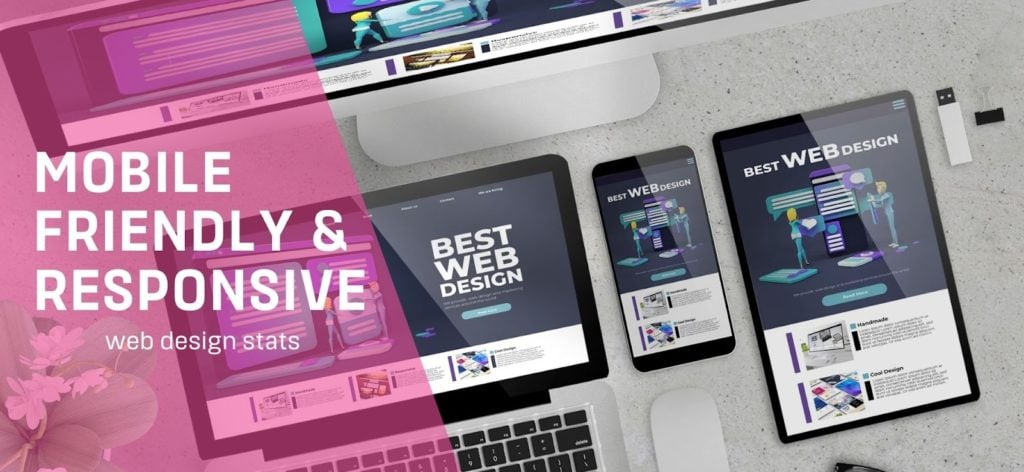
Since the introduction of smartphones, more brands have been adapting to a responsive and mobile-friendly approach when it comes to web design, and it is becoming a requirement for a successful website.
Everyone is busy and on the go these days, making mobile devices essential for browsing, finding information and completing transactions. Mobile-friendly and responsive websites make it easier to do all this.
1. 52.2 percent of all website traffic is generated from mobile phones. (WebFX)
Mobile phones are more accessible and portable than desktop or laptop computers and are easy to use for everyone on the go.
2. 61% of internet users have a higher opinion of companies with mobile-friendly website design (WebFX)
3. And almost 60% of users say they will not recommend a business with a poorly designed mobile site. (Intechnic)
Maybe your client doesn’t see the value of having a mobile-friendly website, but it's important to showcase how it elevates their brand image.
4. 8 out of 10 consumers would stop engaging with content that doesn’t display well on their mobile devices. (Ironpaper)
Consumers are primarily using their smartphones to read content on the internet, leading to a demand for better mobile-friendly content.
If you want potential customers to engage with your content, it is crucial to ensure your online content displays well on all devices.
5. 73.1% of web designers believe that a non-responsive design is the top reason visitors leave a website. (GoodFirms)
You want visitors to stay on your website for as long as possible and the design of your website plays a huge part in this.
6. 74% of users are more likely to return to a website if it’s mobile-friendly (WebFX)
You also want visitors to return to your website and majority will if your website is mobile-friendly.
7. 40% of transactions are done via mobile devices. (Blue Coronas)
8. And 61% say they’re more likely to purchase if a website is mobile-friendly. (WebFX)
Mobile technology has made our lives easier and more convenient. In the past, we had to go to a physical store to buy something or make a purchase. Now, all we need is our phone and a credit card.
This means that retailers need to put more effort into their mobile web presence as well as their mobile apps to stay competitive in this digital world and make sure they are reaching their target audience.
9. 68% of the companies that developed a mobile-first website saw a rise in sales (SAG ipl)
Developing a mobile-friendly website may offer a great return on your investment.
10. 53.8% of web designers cite “not being responsive on all devices” as a top reason for redesigning a website. (GoodFirms)
This is the web designer’s time to shine where they can utilize a responsive design on their client’s newly design website.
Navigation web design statistics

In the past, web design was limited to basic navigation. But today, it is more than just a way for users to find and browse through content; it is also about providing an experience.
11. 60% of people said that usability is the most important web design characteristic for online shopping. (Statista)
In the past, people were just looking for a product and then they would go to a store to buy it. But now, people can find almost anything they want on the internet. This means that they need to be able to find these products quickly and easily.
If someone is looking for a specific product, usability is important because it will allow them to quickly find what they are looking for. If someone is not sure what they are looking for, having an easy interface and navigation will help them navigate the website more accessible and faster.
This also helps with conversions because if someone doesn't have an easy time navigating through your site, they might not buy anything from you.
12. When looking at a website for the first time, 38% of consumers look at a page’s layout or navigational links. (Top Design Firms)
Often, a website’s layout is the first thing that a visitor notices when they visit a site for the first time. It is important to have a good layout to make it easier for users to navigate your site.
The navigation links should be easily accessible and clear. This will help website visitors find what they are looking for efficiently.
Your content should be organized so that it is easy for visitors to find what they want.
13. People spend around 6 seconds looking at the navigation bar. (Missouri University of Science and Technology)
This is the first thing they see on a website, and it's an integral part of the user experience.
It should be simple, straightforward and easy to understand so that people can find what they're looking for.
14. 36% of website visitors click on your logo to reach your homepage from other pages. (Web Alive)
In an era where customers have access to a lot of information about your company, it is crucial to make sure that they can find your company’s homepage from anywhere on the website.
Logos are one of the most recognizable features on any website, and they help customers find the homepage and make it easy for them to navigate through the website.
This means that if your logo is not visible, some website visitors will not know how to reach your homepage from any page on the site.
Content web design statistics

These web design statistics show how content is evolving and what kind of content is in demand.
15. Company contact information is important for 44% of website visitors. (Ko Marketing)
Websites that have contact information on their homepage are more likely to have visitors ready to buy. It is good for companies to make sure that their contact information is prominently displayed on the homepage so that people know where to find them.
Contact details like phone numbers, email addresses, and social media profiles should be displayed on the website's homepage.
16. 86% of visitors who land on a company's website homepage say they want to see information about its products and services. (Ko Marketing)
Knowing how to promote one's products and services effectively is a challenge for many companies. However, 86% of visitors who land on a company's website homepage say they want to see information about its products and services.
17. 85% of customers trust online reviews as much as personal recommendations. (Web Alive)
Online reviews are important to the success of a business. They help people make decisions about what they want to buy and where they want to go. 85% of customers trust online reviews as much as personal recommendations, which means that online reviews are an essential part of marketing for any company.
18. Pages with videos keep users on them for 88% longer. (Web FX)
Videos are a great way of engaging with users on your site. They can be used for anything from product demonstrations to tutorials for new products.
19. 70% of small business websites fail to display a clear call-to-action. (Small Business Trends)
A call-to-action is any form of communication that encourages a particular response. It can be the most important part of your marketing strategy, as it is what compels people to take action and buy your product or service.
20. Users spend 80% of their time viewing information on the left of the page (NNGroup)
Users spend 80% of their time viewing information on the left of the page. The right side of the page is used for navigation, advertisements and promotions.
This is due to the fact that people are more likely to read the information on the left side of a page than they are on the right.
21. On average, companies with blogs produce an average of 67% more leads monthly than companies that don't blog. (DemandMetric)
Blogging is a great way to establish a company’s credibility and expertise in the digital space, as well as an efficient way of reaching out to customers.
A blog is also an effective marketing tool because it provides exposure for the company and its products by providing value.
22. On average, users spend 5.59 seconds per page on a website's written content. (SWEOR)
The average user has a short attention span and will not read the content on your website if it does not immediately catch their attention.
It is important to know what type of content your target audience prefers so that you can tailor the content on your website to suit them. This will increase their chances of staying on your page.
Visual design statistics
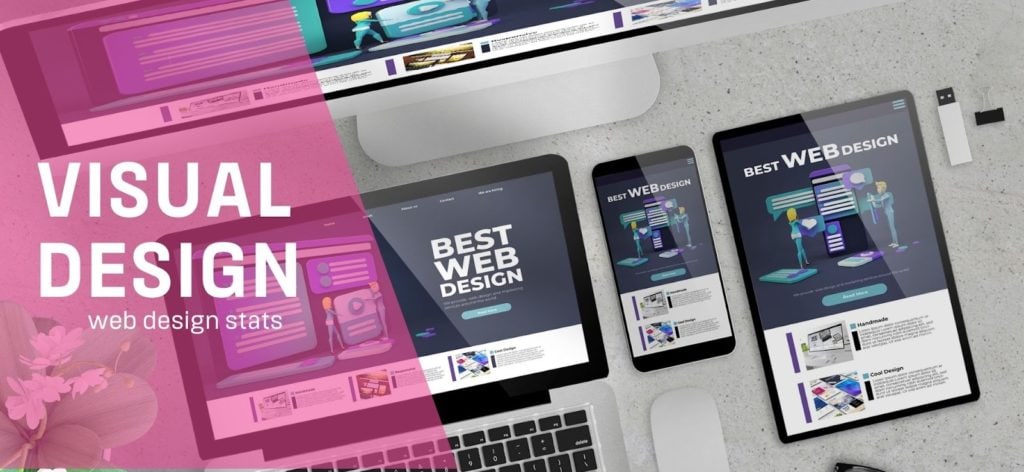
Visual design is a popular topic in the website design field, and it's no surprise that this plays an important role in many of these web design statistics.
The visual design can make or break your website traffic and conversion rates.
23. 59% of people prefer browsing ‘beautiful and well-designed’ sites to basic ones. (Adobe)
The use of aesthetically pleasing design is becoming more and more important for websites.
24. Red buy buttons can increase sales, and conversions on e-commerce websites can increase by 34%. (CXL)
But the study also found that it is because it is a high contrast colour that stands out from the rest of the page, not particularly because it is the colour red.
25. 84.6% of web designers believe crowded website design is the most common mistake made by small businesses. (GoodFirms)
Crowded designs are challenging to navigate and can be confusing. It also makes your site look unprofessional, which can turn off potential customers. You want your site to look clean, clear and professional.
26. 90% of shoppers believe image quality is the most important factor when making online purchases. (Meero)
Online shoppers want to see what they are buying in great detail. They need to be able to zoom in and examine the product; therefore, the quality of an image is very important for online shoppers. It influences their decision about whether or not they will buy a product.
Images are also very important for SEO, as search engines have become more visual and rely on pictures for ranking purposes.
27. Using larger product photos can increase sales by more than 9%. (Meero)
Nowadays, online shoppers are more likely to buy a product if they can see it in detail. Many retailers are using larger product photos on their websites to give the customer a better look at the product.
28. A colour theme improves website recognition by 80% (Forbes)
Color theme can make or break a website. Choosing the right colour scheme for your site can help you stand out from the competition, generate brand recognition and increase conversion rates.
29. When asked what visual elements they value on a company website, 40% of consumers said images, 39% said colour, and 21% said video. (Top Design Firms)
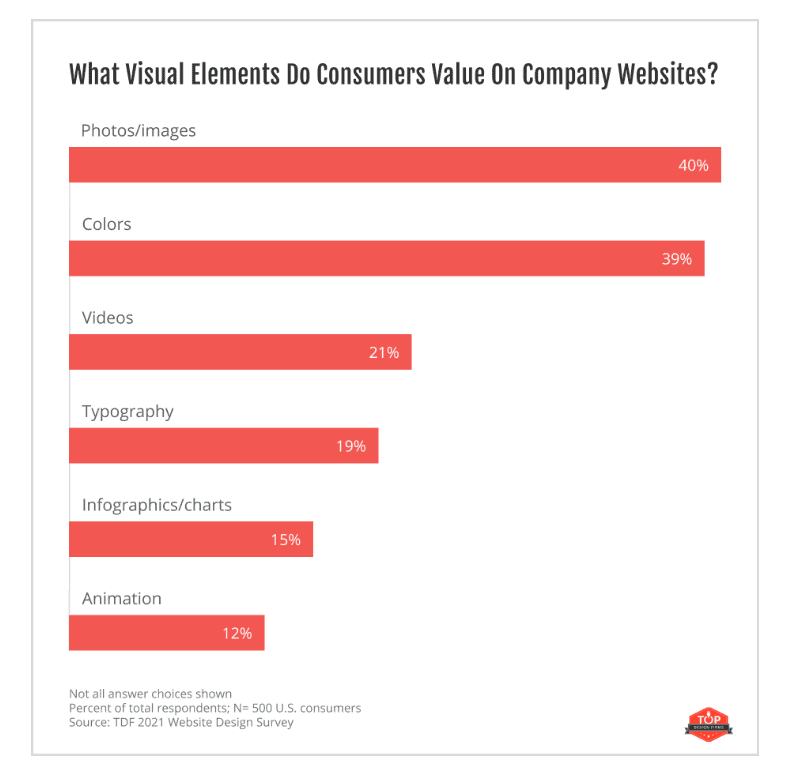
Images and colours are important aspects of the design that attracts a customer’s attention, with video not far behind.
30. 26% of consumers prefer primary colour schemes, 21% prefer complementary, and 20% prefer analogous. (Top Design Firms)
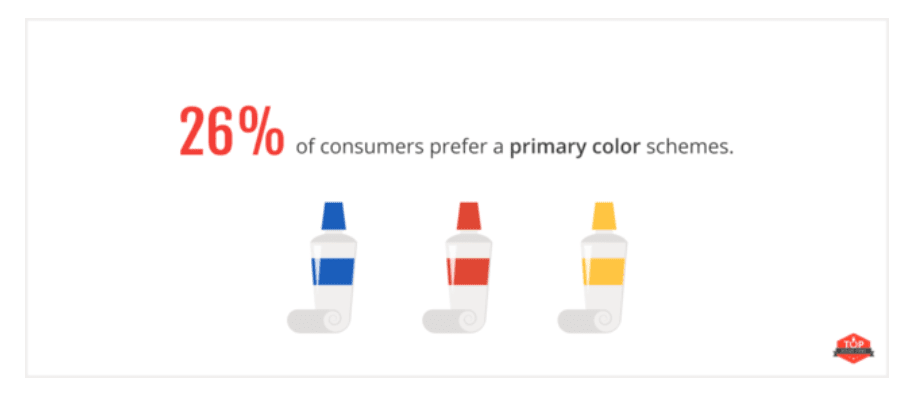
Colour can have a significant impact on the way people perceive a company so companies should consider their products and services before selecting which colour scheme works best.
31. 22% of consumers visiting a website for the first time look for eye-catching colours. But 21% of consumers will leave a site with “outlandish” colours. (Top Design Firms)

The use of colours in a website is vital for its success. Colours can affect the moods of the visitors, can create an atmosphere, and can even influence how people read the content.
This means that while it is important to make sure your site has eye-catching colours, it is also very important to make sure those colours are not too distracting or too loud.
Web design trend statistics
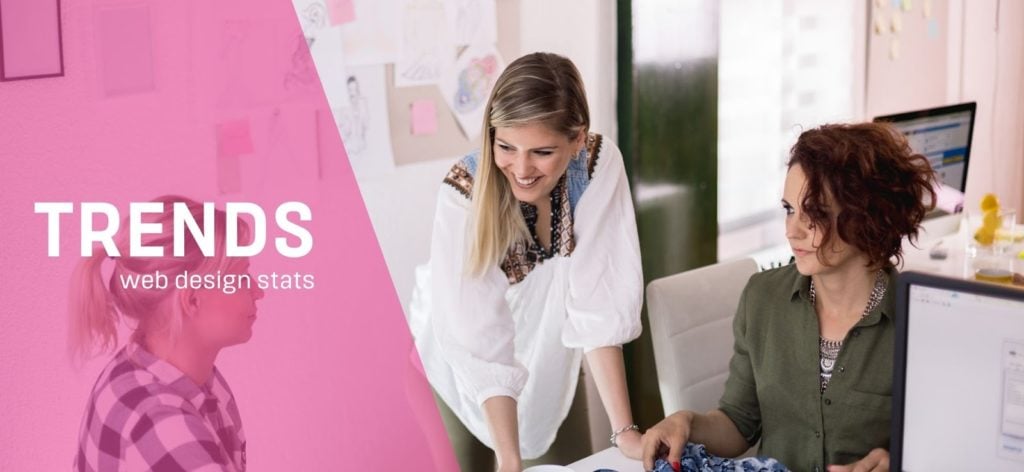
In today’s world, web design trends are changing at a rapid pace. We are constantly learning new things and adapting to the ever-changing environment.
32. 88.5% of website designers reported that ‘Flat design’ is currently the most popular design trend. (GoodFirms)
This trend is popular because it allows interface plans to be more streamlined and proficient. It is also easier to make it responsive to changes across different mobile devices.
It's simple and minimalistic, using simple elements, typography and flat colours. It doesn’t use any shadows, gradients or textures.
Flat design has been around for a while now, but it has only recently started to dominate the web design industry.
33. 61.5% of website designers said that they are currently using expressive typography in their designs (GoodFirms)
Website designers are increasingly using expressive typography to create a more attractive and engaging user experience.
These websites use techniques such as font size, colour, spacing, and weight to help convey information. The most common form of expressive typography is the use of bold text to emphasize certain words or phrases.
Website speed statistics

One key success factor for web design is speed. A website that loads quickly will be more likely to keep visitors on the site for longer periods of time, as well as improve ranking and increase conversions.
34. 53% of website visits are abandoned if a mobile site takes longer than three seconds to load. (Google)
Mobile users are more impatient than ever. They expect a website to load in 3 seconds or less, and if it doesn’t they will just leave.
35. Google has indicated that website speed is one of the signals used by its algorithms to rank pages. (MOZ)
This means that if your website is not optimized for speed, then you are going to be penalized for it, therefore, making it a critical piece of the website design.
36. In retail, a one-second delay in mobile load times can impact conversion rates by up to 20% (Google)
Website load speed is one of the most important performance indicators for converting customers.
When it comes to loading time, the faster a site loads, the better chance it has of getting more people through the virtual door and having them buy.
37. 45% of people are less likely to make a purchase when an e-commerce site loads slower than expected. (Unbounce)
This is largely due to impatience, as people want their shopping experience to be fast and efficient.
38. 39% of users will stop engaging with your website if it takes too much time to load. (Web Alive)
It is crucial to have a website that loads quickly. If the loading time is too long, not only will the user not buy but they will get frustrated, stop engaging altogether and will go to another website.
39. 88.5% of website designers believe slow loading is the main reason people leave a website (GoodFirms)
The website loading speed is one of the most important metrics for a website. It is a crucial factor that affects the user experience and conversion.
General web design statistics
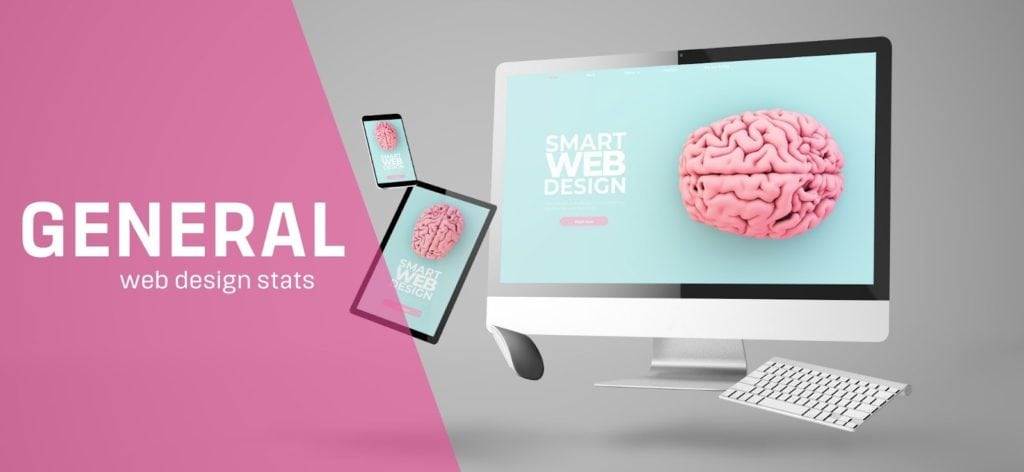
Web design is an industry that is constantly changing. As the internet evolves, so does the way that we design websites. These stats are important to web designers who are looking for new ways to improve their skills and stay on top of trends.
40. 88% of consumers say they have higher expectations for businesses’ digital capabilities since COVID-19. (Salesforce)
Consumers are more aware of the potential digital capabilities of businesses. This is because they have seen how companies have adapted to the world around them and accelerated their adoption of technology.
It is important for businesses to stay up-to-date with the latest technologies and trends in order to meet consumer expectations.
41. In the US, 23% of small retail businesses don’t have a website. (Digital.com)
Many small retail businesses still rely on traditional methods of advertising and marketing, despite the increase in e-commerce sales.
42. 24% of small retail businesses without a website responded that their reason for not having one was that they don’t know how to create and run a website. (Digital.com)
It can be difficult for small businesses to create a website if they have never done so, but this is an opportunity to educate those businesses on the importance of having a website, the return on their investment and helping create a website that suits their business.
43. Employment of web developers and digital designers is projected to grow 13 percent from 2020 to 2030, much faster than the average for all occupations. (U.S. Bureau of Labor Statistics)
The demand for web developers and digital designers is expected to grow in the coming years. In fact, the Bureau of Labor Statistics predicts that employment for these positions will grow 13% from 2020 to 2030.
This growth rate is much faster than the average for all occupations, which is about 8%.
44. The median annual wage for web developers and digital designers was $77,200 in May 2020. (U.S. Bureau of Labor Statistics)
Keep in mind this median annual wage doesn’t take into account experience level or location where they live.
45. It takes 0.05 seconds for users to create an opinion about your website (TandFOnline)
User experience is the most important part of any website. It's not just about how your website looks, but also about how it functions.
The first impression is what counts the most. Users will form an opinion about your site in 0.05 seconds and if they don't like it, you can say goodbye to them and their business. That's why it's so important to make sure that your website looks good on all devices and that you provide a smooth user experience.
46. Low conversion rate is the top reason people redesign websites (GoodFirms)
More and more people are finding it easier to buy products from their computers and therefore it is important that your site is optimized for conversion. The website should attract potential customers and convert them into actual customers.
Company brand image

When it comes to designing a company's website, it is important that it showcases the company’s brand. So many opinions are formed about a brand just by the website and you want to make that first impression a positive one for their potential customers.
47. Website design is an important factor for determining credibility for 48% of visitors (Blue Corona)
The way a website looks, the colours it uses, and the quality of its content all contribute to how credible it appears to be.
48. 73% of companies are investing in design to differentiate their brands. (Blue Corona)
Design has always been an integral part of branding, but in the digital age, it is more important than ever to differentiate your brand. Website design can be used to create a powerful emotional connection with potential customers and turn them into actual customers just from their website and digital presence.
49. Around 50% of internet users say that website design is a crucial factor in formulating an opinion about a brand. (Top Design Firms)
Website design is crucial for companies to maintain a good reputation. It can be the first impression for potential customers, and it can also be a deciding factor in whether or not they decide to buy from that company.
See, web design statistics can be interesting
Web design is an industry that changes rapidly and it's important to stay up-to-date with the latest trends. These statistics really show what your visitors are looking for which if web design is done right, will convert visitors into customers and be a great return on investment for your clients.
It’s clear that technology isn’t going anywhere and companies will need to step up and have an up-to-date online presence to stand out amongst the competition. These web design statistics prove that if businesses aren’t implementing some of these strategies (or worse, don’t have a website yet!), they will fall behind.



